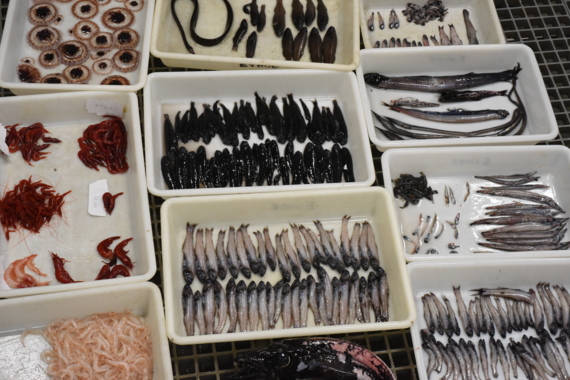COREPH (Since 2014)
Observing Chemical Contamination of Food Webs
Ifremer Coordination | Type of project | Financing | Project duration | Link |
A. Mauffret (DCSMM) | National | DEB | Since 2014 |
COREPH monitoring is implemented as part of the Marine Strategy Framework Directive (MSFD) monitoring program (namely PdS in French). It is divided into 2 parts: monitoring on the continental shelf and monitoring in deep pelagic environment (200-2000m).
- At the level of the continental shelf, COREPH aims to respond to a joint request for descriptors 4 (food webs), 8 (contaminants) and 9 (health questions), in order to acquire data that meet the needs of the MSFD on the trophic level and contaminant concentrations (organic and metallic) in different species of fish and cephalopods. The deployment of this system is based on the protocol for optimizing the Data Collection Framework (DCF) fishing campaigns operated by Ifremer in the three French metropolitan marine sub-regions. Due to the “shared” dimension of COREPH, monitored species are of interest for the three descriptors and, as far as possible, analyses for these 3 descriptors are performed on the same individuals. This approach also makes it possible to limit the additional work to be carried out on board and increases the scientific relevance of the results. IFREMER, ANSES and the PELAGIS observatory (UMS 3462 La Rochelle Université-CNRS) are involved in this system.
- In a deep pelagic environment (meso- and bathypelagic), COREPH focus on the oceanic micronecton (ie crustaceans, fish and cephalopods of relatively small size, generally between two and twenty centimeters) taken from the canyons of the continental slope. Micronecton plays a central role both in the food web functioning by ensuring the transfer of energy from plankton to higher predators, but also in certain biogeochemical cycles of these deep pelagic ecosystems as a component of the "organic pump". However, the oceanic micronecton and more generally deep ecosystems have been the subject of very few studies in France to date. A significant effort should therefore be made to monitor and assess the ecological state of this essential reservoir for marine biodiversity. In 2017 and 2018, D1, D4, D8 shared monitoring of these communities was carried out through a series of trawls carried out on the EVHOE fishing campaigns in the Bay of Biscay. The first results of this study thus confirmed the rich biodiversity and the complexity of the trophic network in the meso to bathypelagic zone. However, the most striking conclusions were linked to the demonstration of chemical contamination of deep pelagic ecosystems of the Bay of Biscay by historical and emerging POPs, and also by certain potentially toxic metals measured in fifteen species representative of the community studied. The data obtained made it possible to define a reference state of the current contamination of these populations in the Bay of Biscay and confirmed the potential for long-term monitoring of these communities to provide indicators of Good Ecological Status.
As such, COREPH constitutes a unique monitoring combining information on biodiversity and its contamination along the coastal waters to the deep layers of the ocean continuum.
Diversity of species caught (jellyfish, crustaceans, fish) during mesopelagic trawling at 700-800 m depth on EVHOE cruises.
Ifremer staff | Academic partners |
Ifremer Boulogne, ODE Vigies | LABERCA, ANSES, PELAGIS |
Principle results :
Mialet Benoit, Banaru Daniela, Baudrier Jerome, Bustamante Paco, Chekri Rachida, Cresson Pierre, Harmelin Mireille, Le Loc'h François, Mauffret Aourell, Marchand Philippe, Petit Laetitia, Prieur Solene, Saibi-Yedjer Lynda, Serre Sandrine, Spitz Jerome, Timmerman Charles-Andre, Vouriot Pauline, Wessel Nathalie (2017). Bilan des essais et optimisation du suivi mutualisé « réseaux trophiques et contaminants » sur les campagnes halieutiques DCF 2014- 2015. Rapport pour le projet DCSMM . https://archimer.ifremer.fr/doc/00373/48447/
Mauffret Aourell, Wessel Nathalie, Chouvelon Tiphaine, Cresson Pierre, Banaru Daniela, Bustamante Paco, Baudrier Jerome, Mialet Benoit, Saibi-Yedjer Lynda, Spitz Jerome, Bouchoucha Marc, Mille Tiphaine, Le Loch Francois, Harmelin Vivien Mireille (2019). Fish contamination and trophodynamic in three French subregions. 2019 Future Oceans2 IMBeR Open Science Conference, 17-21 June 2019, Brest, France.
Wessel Nathalie, Chouvelon Tiphaine, Baudrier Jerome, Saibi-Yedjer Lynda, Spitz Jérôme, Mille Tiphaine, Bouchoucha Marc, Mauffret Aourell (2019). Suivi des Contaminants dans les Réseaux troPhiques (CoRePh), dans le contexte du programme de surveillance de la Directive Cadre Stratégie pour le Milieu Marin : exemple en Méditerranée. 14e colloque de l'AFH "Recherche Halieutique et Développement Durable". 26 au 28 juin 2019, Université de Caen Normandie.
Cresson Pierre, Chouvelon Tiphaine, Bustamante Paco, Bănaru Daniela, Baudrier Jerome, Le Loch Francois, Mauffret Aourell, Mialet Benoit, Spitz Jérome, Wessel Nathalie, Briand Marine, Denamiel Margaux, Doray Mathieu, Guillou Gaël, Jadaud Angelique, Lazard Coline, Noûs Camille, Prieur Solène, Rouquette Manuel, Saraux Claire, Serre Sandrine, Timmerman Charles-Andre, Verin Yves, Harmelin-Vivien Mireille (2020). Primary production and depth drive different trophic structure and functioning of fish assemblages in French marine ecosystems. Progress In Oceanography , 186, 102343 (14p.) . https://doi.org/10.1016/j.pocean.2020.102343


